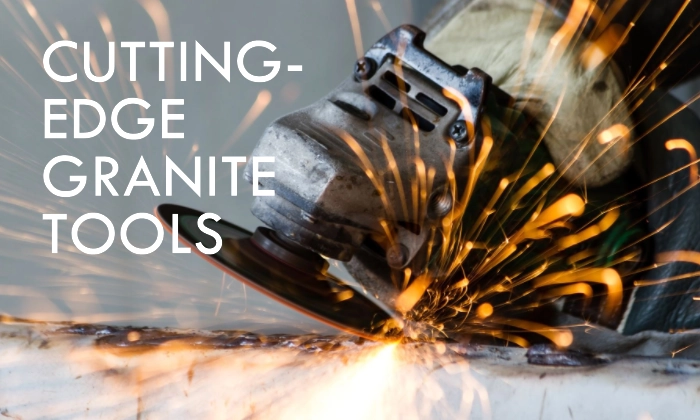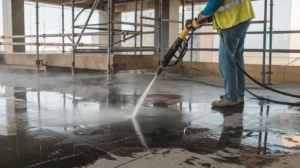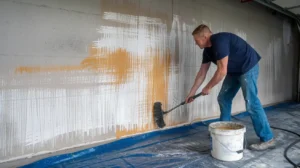How to Clean Concrete Floor effectively is essential to maintaining...
Read MoreTop 10 Granite Cutting Tools for Precise Stone Crafting
Granite cutting tools play a pivotal role in the world of stone crafting, where granite stands out for its durability and elegance. Whether you’re a professional stone worker or a DIY enthusiast, having the right tools is essential for achieving precise cuts and polished finishes.
In this article, we’ll delve into the top 10 granite cutting tools that you need to consider. From granite cutting machines to saws and DIY tips, Stone Sealer & Restoration has got you covered.

Essential Safety Precautions
Before delving into the world of granite cutting, it’s crucial to prioritize safety. Working with granite cutting tools can pose risks if not approached with care and caution. To ensure a secure and productive experience, always adhere to these essential safety precautions:
Wear Appropriate Safety Gear:
Prioritize your safety by wearing the necessary protective gear. Safety goggles shield your eyes from debris and particles, gloves offer hand protection, and hearing protection guards against the noise generated by the cutting tools.
Choose the Right Clothing:
Opt for clothing that covers your arms and legs to minimize exposure to dust and debris. Avoid loose-fitting attire that might get caught in the equipment.
Respiratory Protection
Depending on the cutting method, you might encounter dust and fine particles. Use a dust mask or respirator to prevent inhaling harmful materials.
Secure the Workspace
Set up your workspace in a well-ventilated area to dissipate dust and fumes. Remove clutter and obstacles that could hinder your movement.
Read the Manuals
Familiarize yourself with the operation manuals of the tools you’re using. Understanding the correct usage and safety features of each tool is essential.
Inspect Tools and Equipments
Before each use, thoroughly inspect your cutting tools and equipment. Ensure they’re in proper working condition, free from defects, and have the appropriate safety guards.
Stay Focused
Distractions can lead to accidents. When operating cutting tools, maintain your focus on the task at hand to prevent any mishaps.
Follow Manufacturer’s Guidelines
Adhere to the manufacturer’s guidelines for each tool and machine. This includes proper assembly, operation, and maintenance.
Keep Hands Clear Never place your hands near the cutting area while the tool is in operation. Utilize appropriate tools to manipulate the material being cut.
Use Proper Techniques
Learn and employ correct cutting techniques to minimize the risk of kickbacks and other accidents.
Avoid Rushing
Take your time when cutting granite. Rushing increases the likelihood of mistakes and accidents.
Emergency Procedures
Familiarize yourself with emergency shutdown procedures for each tool and machine. Know the locations of emergency stops and switches.
Proper Blade Selection
Ensure that you’re using the correct type and size of blade for the specific cutting task. Using the wrong blade can lead to dangerous situations.
Secure Material
Always secure the granite material firmly in place before cutting. This prevents it from moving or shifting during the cutting process.
Proper Handling and Storage
When not in use, store your cutting tools in a safe and secure location. Keep them out of reach of children and unauthorized individuals.
By following these safety precautions, you’re taking proactive steps to protect yourself and those around you while engaging in granite sealing activities.
Remember that safety should always be your top priority, and a responsible approach ensures a successful and incident-free experience.
Granite Cutting Basics
Granite cutting is a meticulous process that involves transforming raw granite slabs into specific shapes and sizes for various construction and decorative purposes.
Whether you’re a professional contractor or a DIY enthusiast, understanding the basics of granite etching and cutting is essential to achieve accurate and visually appealing results. Let’s explore the fundamental aspects of granite etching and cutting:
Different Types of Granite Cuts
Granite can be cut in various ways to achieve different shapes and designs. Some common types of cuts include:
- Straight Cuts: These are basic linear cuts used for creating straight edges or sections of granite.
- Curved Cuts: Curved cuts are used to create rounded or intricate shapes in the granite material.
- Beveled Cuts: Beveled cuts involve cutting the edges of the granite at an angle to create a sloping effect.
Each type of cut requires specific tools and techniques to achieve the desired outcome.
Granite Cutting Tools Needed for Basic
To perform basic granite cutting, you’ll need a set of essential granite cutting tools, including:
- Diamond Circular Saw Blades: These specialized blades are equipped with diamond segments, allowing them to cut through the tough granite material efficiently.
- Angle Grinder with Diamond Blade: An angle grinder fitted with a diamond-tipped blade is versatile for shaping and cutting granite.
- Measuring and Marking Tools: Accurate measurements and markings are crucial for precise cuts. A tape measure, straightedge, and chalk line are commonly used tools.
- Safety Gear: Personal protective equipment, including safety goggles, gloves, and hearing protection, ensures your safety while cutting granite.
- Clamps and Supports: These tools are essential for securing the granite slab in place to prevent movement during cutting.
- Dust Control Equipment: Granite cutting tools generate dust and debris. Dust masks and dust control systems help keep the workspace clean and protect your respiratory health.
By familiarizing yourself with these basic granite cutting tools and their uses, you’ll be better prepared to tackle granite-cutting projects effectively.
Getting Started with Granite Cutting Tools
Before you begin cutting granite, it’s crucial to follow a systematic approach:
- Prepare the Workspace: Set up your workspace in a well-ventilated area with proper lighting. Clear away any clutter and create a safe working environment.
- Select the Granite Slab: Choose the appropriate granite slab for your project based on its size, color, and pattern. Ensure the slab is securely positioned for cutting.
- Measure and Mark: Measure and mark the desired cuts on the granite slab using measuring tools and chalk lines. Double-check your measurements to ensure accuracy.
- Secure the Slab: Use clamps or supports to secure the granite slab in place. This prevents it from moving while you’re cutting.
- Wear Safety Gear: Put on your safety goggles, gloves, and other protective gear to safeguard yourself from potential hazards.
- Begin Cutting: Depending on the type of cut you’re making, use the appropriate tool. For straight cuts, a diamond circular saw blade is ideal. For shaping or detailed cuts, an angle grinder might be more suitable.
- Follow the Markings: Carefully guide the cutting tool along the marked lines. Maintain a steady pace and avoid forcing the tool through the granite.
- Check the Progress: Periodically check the progress of your cuts to ensure they’re following the intended path and angle.
- Refine the Edges: After making the cuts, use sandpaper or polishing pads to smooth and refine the edges of the granite.
- Clean Up: Clean up the workspace by removing dust and debris. Properly store your tools and equipment.
Remember that practice and patience are key to mastering granite countertop cutting techniques. Whether you’re crafting intricate designs or making straightforward cuts, a solid understanding of the basics will set you on the path to achieving impressive granite countertop creations.
Top 10 Granite Cutting Tools

Diamond Circular Saw Blades
These blades are equipped with diamond segments that provide excellent cutting efficiency and durability. They’re ideal for making straight cuts on granite slabs.
Diamond Wire Saws
Wire saws use diamond-embedded wires to cut through granite. They’re suitable for intricate cuts and can also cut large blocks into manageable pieces.
Diamond Hole Saws
When you need to create holes in granite for faucets, sinks, or electrical outlets, diamond hole saws are essential.
Masonry Saws
Masonry saws are versatile and can handle cutting through various hard materials, including granite.
Angle Grinders
Angle grinders equipped with diamond cutting wheels are perfect for shaping and cutting granite.
Wet Polishers
After cutting, wet polishers help achieve a smooth finish on granite edges and surfaces.
Router Bits
Router bits are used to create decorative edges and profiles on granite countertops and surfaces.
Diamond Core Bits
Core bits are designed for drilling holes in granite. They’re commonly used for faucet and sink installations.
Bridge Saws
Bridge saws are large machines used for precise and complex cuts on granite slabs.
Water Recycling Systems
Water recycling systems collect and filter water used during cutting to reduce waste and maintain a clean workspace.
Granite Cutting Machines
Bridge Saw Machines
Bridge saw machines are automated cutting systems that offer high precision for large-scale granite cutting projects.
CNC Granite Cutting Machines
Computer Numerical Control (CNC) machines use digital designs to guide precise cuts and shapes on granite slabs.
Portable Handheld Machines
These machines offer convenience and portability for smaller projects and on-site cutting needs.
Granite Cutting Techniques
Wet Cutting vs. Dry Cutting
Wet cutting uses water to cool the blade and suppress dust, resulting in cleaner cuts and longer blade life. Dry cutting generates more dust but can be suitable for certain situations.
Precision Cutting and Shaping
Precision is crucial in granite cutting, especially when dealing with intricate designs or matching pieces for seamless installations.
Curved Cuts and Contours
Granite’s hardness makes curved cuts challenging. Specialized granite cutting tools and techniques are used to achieve smooth curves and contours.
Granite Cutting and Polishing
Steps for Cutting and Shaping Granite
The cutting process involves marking the granite, setting up the saw, making the cuts, and refining the edges.
Polishing Process and Tools
Polishing granite surfaces requires diamond polishing pads and gradual grit progression to achieve a mirror-like finish.

Granite Cutting Safety Measures
Personal Protective Equipment (PPE)
Safety goggles, gloves, hearing protection, and dust masks are essential to protect yourself from potential hazards.
Proper Workspace Setup
Maintain a clutter-free workspace with adequate lighting and ventilation for safe and efficient granite cutting.
Safe Tool Handling
Follow manufacturer guidelines for operating granite cutting tools and equipment to prevent accidents and ensure optimal performance.
DIY Granite Cutting Tips
Choosing the Right Granite Slab
Select a high-quality slab that suits your project’s requirements in terms of color, pattern, and size.
Step-by-Step DIY Cutting Guide
Plan your cuts, mark the slab, secure it properly, and follow a steady cutting pace for best results.
Common Mistakes to Avoid
Avoid rushing the cutting process, neglecting safety gear, and using incorrect techniques to prevent costly errors.
Granite Cutting Professionals Near You
Researching Local Granite Cutting Services
When in need of professional assistance, research local granite cutting services and read reviews to make an informed choice.
Factors to Consider When Hiring
Consider experience, expertise, equipment, and pricing when selecting a granite cutting professional for your project.
Conclusion
Mastering the art of granite cutting requires the right granite cutting tools, expertise, and guidance. Stone Sealer & Restoration is your go-to resource for all things related to granite cutting, from tools and techniques to professional services.
Whether you’re a seasoned professional or a DIY enthusiast, our comprehensive guide has provided you with the insights you need to embark on successful granite cutting projects.
For further information, don’t hesitate to get in touch with us. Your journey towards successful granite cutting starts with Stone Sealer & Restoration.
FAQs (Frequently Asked Questions)
What Is The Best Tool For Making Curved Cuts In Granite?
To make curved cuts in granite, a diamond contour blade or a curved blade attachment for a wet polisher is recommended.
Can I Use A Regular Saw Blade For Cutting Granite?
It’s not recommended. Granite is a dense material that requires diamond-tipped blades for effective cutting.
How Do I Choose The Right Diamond Blade For My Granite Cutting Project?
Consider the blade diameter, arbor size, and cutting speed compatibility with your equipment.
Is DIY Granite Cutting Suitable For Beginners?
While it’s possible, it’s advisable to start with smaller, less intricate projects and gradually build your skills.
What’s The Advantage Of Using A Water Recycling System In Granite Cutting?
Water recycling systems help reduce water wastage, keep the workspace clean, and minimize environmental impact.
Our Services
Our Recent Post
How to Remove Paint from Concrete
How to Remove Paint from Concrete can be a challenging...
Read MoreTop 7 Popular Quartz Countertops Colors in 2024
Quartz countertops colors are at the forefront of modern interior...
Read MoreHow to Clean a Granite Composite Sink | Simple Steps for a Spotless Finish
How to Clean a Granite Composite Sink starts with understanding...
Read More



